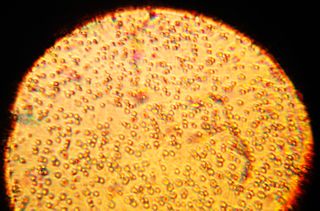Soy formula is a substitute for human breast milk. It is a commercial product based on the proteins found in soybeans. Soy infant formula uses processed soybeans as its source of protein, and comes in powdered or liquid form. [1] Usually lactose-free, soy infant formula contains a different sugar. Infants who are intolerant of cows' milk protein may also be intolerant of soy protein. It differs from human breast milk in a number of ways. [2] Soy protein inhibits the absorption of iron. The soy-based formulas discussed by the World Health Organization reports that soy formula is fortified with iron to compensate for this effect. [3] One naturally occurring plant-based compound found in soy-based infant formula is phytic acid. It is also a strong inhibitor of iron absorption, though it can be removed in processing. It is not known how many manufacturers of soy-based formula incorporate this practice. China and Vietnam have regulated soy-based infant formulas to include NaFeEDTA (sodium-feric ethylenediaminetetraacetic acid) to fortify the formula and enhance the absorption of iron by the infant. When iron compounds are added to soy-based infant formula, the iron compound is encapsulated to prevent it from making the formula dark. [4]
Genetically modified ingredients may be present in soy-based infant formula. It may also be of lower nutritional value. [5] Soy-based infant formula can have aluminum, phytates, and phytoestrogens (isoflavones) that might cause unanticipated effects. Other constituents are amino acids: such as taurine, methionine, and carnitine. Added minerals are phosphore, calcium, iron, and zinc. SIF also contains soy-isolate that supplies 95% of protein.
Breastfeeding is still the best option for feeding infants. [6] There are instances when breastfeeding is not possible and the use of formula is appropriate. [5]
Indications for the use of soy-based infant formula are galactosaemia and lactase deficiency. When a child develops an allergy to cows' milk, soy-based formula is used. SBF is less costly than other breast milk formula substitutes. [6]
Past reports of the effects of soy formula have suggested that a constituent of soy formula may affect reproductive functions. However, studies have shown that no correlation exists between the consumption of soy formula and abnormality in reproductive anatomy or function. [7] Soy-based infant formula has been used for over the past 100 years. By late 1800s and the early 1900s, supplementation of breastfeeding with formula was acceptable. [5] Soy-based formula was used as early as 1909. [6]
Soy-based infant formula is associated with allergies in infants. [8] Chronic food protein-induced enterocolitis syndrome (FPIES) has been observed in infants aged younger than three months who were fed with soy formula. [9] France has taken soy-based infant formula off the market. Soy-base formula accounts for about 20% of the infant formula purchased in the US. In New Zealand formula use is around 10%, and in Belgium and the UK and about 5%. [6]

Lactose intolerance is caused by a lessened ability or a complete inability to digest lactose, a sugar found in dairy products. Humans vary in the amount of lactose they can tolerate before symptoms develop. Symptoms may include abdominal pain, bloating, diarrhea, flatulence, and nausea. These symptoms typically start thirty minutes to two hours after eating or drinking something containing lactose, with the severity typically depending on the amount consumed. Lactose intolerance does not cause damage to the gastrointestinal tract.

The soybean, soy bean, or soya bean is a species of legume native to East Asia, widely grown for its edible bean, which has numerous uses.

Infant formula, also called baby formula, simply formula, baby milk or infant milk, is an ultra-processed food designed and marketed for feeding to babies and infants under 12 months of age, usually prepared for bottle-feeding or cup-feeding from powder or liquid. The U.S. Federal Food, Drug, and Cosmetic Act (FFDCA) defines infant formula as "a food which purports to be or is represented for special dietary use solely as a food for infants by reason of its simulation of human milk or its suitability as a complete or partial substitute for human milk".

Casein is a family of related phosphoproteins that are commonly found in mammalian milk, comprising about 80% of the proteins in cow's milk and between 20% and 60% of the proteins in human milk. Sheep and cow milk have a higher casein content than other types of milk with human milk having a particularly low casein content.

A food allergy is an abnormal immune response to food. The symptoms of the allergic reaction may range from mild to severe. They may include itchiness, swelling of the tongue, vomiting, diarrhea, hives, trouble breathing, or low blood pressure. This typically occurs within minutes to several hours of exposure. When the symptoms are severe, it is known as anaphylaxis. A food intolerance and food poisoning are separate conditions, not due to an immune response.

Breast milk or mother's milk is milk produced by mammary glands located in the breast of a human female. Breast milk is the primary source of nutrition for newborns, containing fat, protein, carbohydrates and variable minerals and vitamins. Breast milk also contains substances that help protect an infant against infection and inflammation, whilst also contributing to healthy development of the immune system and gut microbiome.

Baby colic, also known as infantile colic, is defined as episodes of crying for more than three hours a day, for more than three days a week, for three weeks in an otherwise healthy child. Often crying occurs in the evening. It typically does not result in long-term problems. The crying can result in frustration of the parents, depression following delivery, excess visits to the doctor, and child abuse.

A milk substitute is any substance that resembles milk and can be used in the same ways as milk. Such substances may be variously known as non-dairy beverage, nut milk, grain milk, legume milk, mock milk and alternative milk.

Soy allergy is a type of food allergy. It is a hypersensitivity to ingesting compounds in soy, causing an overreaction of the immune system, typically with physical symptoms, such as gastrointestinal discomfort, respiratory distress, or a skin reaction. Soy is among the eight most common foods inducing allergic reactions in children and adults. It has a prevalence of about 0.3% in the general population.

Goat milk is the milk of domestic goats. Goats produce about 2% of the world's total annual milk supply. Some goats are bred specifically for milk. Goat milk naturally has small, well-emulsified fat globules, which means the cream will stay in suspension for a longer period of time than cow's milk; therefore, it does not need to be homogenized. Eventually, the cream will rise to the top over a period of a few days. If the milk is to be used to make cheese, homogenization is not recommended, as this changes the structure of the milk, affecting the culture's ability to coagulate the milk and the final quality and yield of cheese.

Milk allergy is an adverse immune reaction to one or more proteins in cow's milk. Symptoms may take hours to days to manifest, with symptoms including atopic dermatitis, inflammation of the esophagus, enteropathy involving the small intestine and proctocolitis involving the rectum and colon. However, rapid anaphylaxis is possible, a potentially life-threatening condition that requires treatment with epinephrine, among other measures.

Breastfeeding, or nursing, is the process by which human breast milk is fed to a child. Breast milk may be from the breast, or may be pumped and fed to the infant. The World Health Organization (WHO) recommends that breastfeeding begin within the first hour of a baby's life and continue as often and as much as the baby wants. Health organizations, including the WHO, recommend breastfeeding exclusively for six months. This means that no other foods or drinks, other than vitamin D, are typically given. The WHO recommends exclusive breastfeeding for the first 6 months of life, followed by continued breastfeeding with appropriate complementary foods for up to 2 years and beyond. Of the 135 million babies born every year, only 42% are breastfed within the first hour of life, only 38% of mothers practice exclusive breastfeeding during the first six months, and 58% of mothers continue breastfeeding up to the age of two years and beyond.

Donkey milk is the milk from the domesticated donkey (Equus asinus). It has been used since antiquity for cosmetic purposes as well as infant nutrition.
Amino acid-based formula is a type of infant milk formula made from individual amino acids. It is hypoallergenic and intended for infants suffering from severe allergy to milk and various gastrointestinal conditions, such as food protein-induced enterocolitis syndrome and malabsorption syndromes. It is sometimes referred to as elemental formula but this is considered a misleading name. Issues with the use of amino acid-based formula include its high cost and its unpalatable taste. Intake of amino-acid formula for healthy infants shows no advantage in growth.
Food protein-induced enterocolitis syndrome (FPIES) is a systemic, non IgE-mediated response to a specific trigger within food – most likely food protein. FPIES presents in two different forms: an acute form and a chronic form. In its acute form, FPIES presents with vomiting that usually begins 1 to 4 hours after trigger food ingestion. Vomiting is often followed by a paleness to the skin, lethargy, and potentially watery, perhaps blood-tinged diarrhea. In the severe form of acute FPIES, a person will vomit until dehydration and until a shock-like state, which occurs in 15% of patients. In its chronic form, which can be difficult to diagnose until a person has already met diagnostic criteria for acute FPIES, after repeated or regular ingestion of the trigger food, the person presents with chronic or episodic vomiting, failure to thrive, and watery, perhaps blood-tinged diarrhea. FPIES can potentially develop at any age but seems most commonly to develop within the first few years of life. FPIES has mainly been documented in young infants, but can exist in older children and adults. Some people develop both FPIES and an IgE-mediated type of reaction to the same food, and having FPIES can increase a person's risk of also developing IgE-mediated food allergies.
Infant feeding is the practice of feeding infants. Breast milk provides the best nutrition when compared to infant formula. Infants are usually introduced to solid foods at around four to six months of age.
Fish protein powder (FPP) describes a food grade powder product designated primarily for human consumption applications. It differs significantly from fish meal products which are designated for animal feed applications. Fish protein powders have various sanitary processing, purity and functional characteristics which establish them as human food ingredients. Production plants registered for the USA market are located in Peru and France.
Toddler nutrition is the description of the dietary needs of toddlers aged one to two years old. Food provides the energy and nutrients that toddlers need to be healthy. An adequate intake in nutrient rich food is good nutrition. A diet lacking essential calories, minerals, fluid and vitamins could be considered 'bad' nutrition. Nutrition needs are different for toddlers. For a baby, breast milk is "best" and it has all the necessary vitamins and minerals. Toddlers typically have been weaned from breast milk and infant formula. Though infants usually start eating solid foods between 4 and 6 months of age, more and more solid foods are consumed by a growing toddler. If a food introduced one at a time, a potential allergen can be identified. Food provides the energy and nutrients that young children need to be healthy. Toddlers are learning to feed themselves and to eat new foods. They should eat a variety of foods from all the food groups. Each day, toddlers need enough nutrients, including

Human milk immunity is the protection provided to the immune system of an infant via the biologically active components in human milk. Human milk was previously thought to only provide passive immunity primarily through Secretory IgA, but advances in technology have led to the identification of various immune-modulating components. Human milk constituents provide nutrition and protect the immunologically naive infant as well as regulate the infant's own immune development and growth.
Breast milk-mediated drug delivery refers to the use of breast milk to transport a pharmaceutical compound, protein, or other treatment to achieve a desired effect. Delivery of these substances via milk provides an oral alternative for transport of a compound to the gut, specifically in infants. Breast milk-mediated drug delivery provides a way for pharmaceuticals and proteins to travel through the gastrointestinal system of an infant while minimizing the potential for irritation within gastrointestinal tissue.